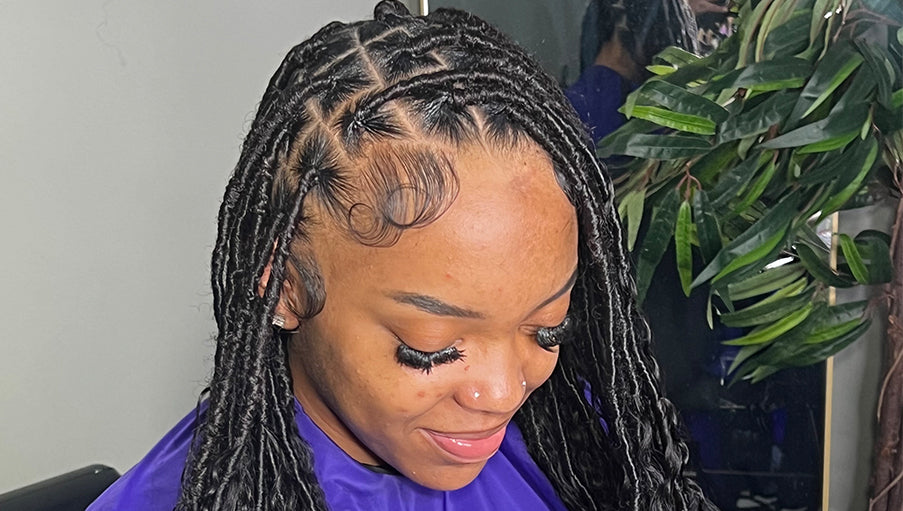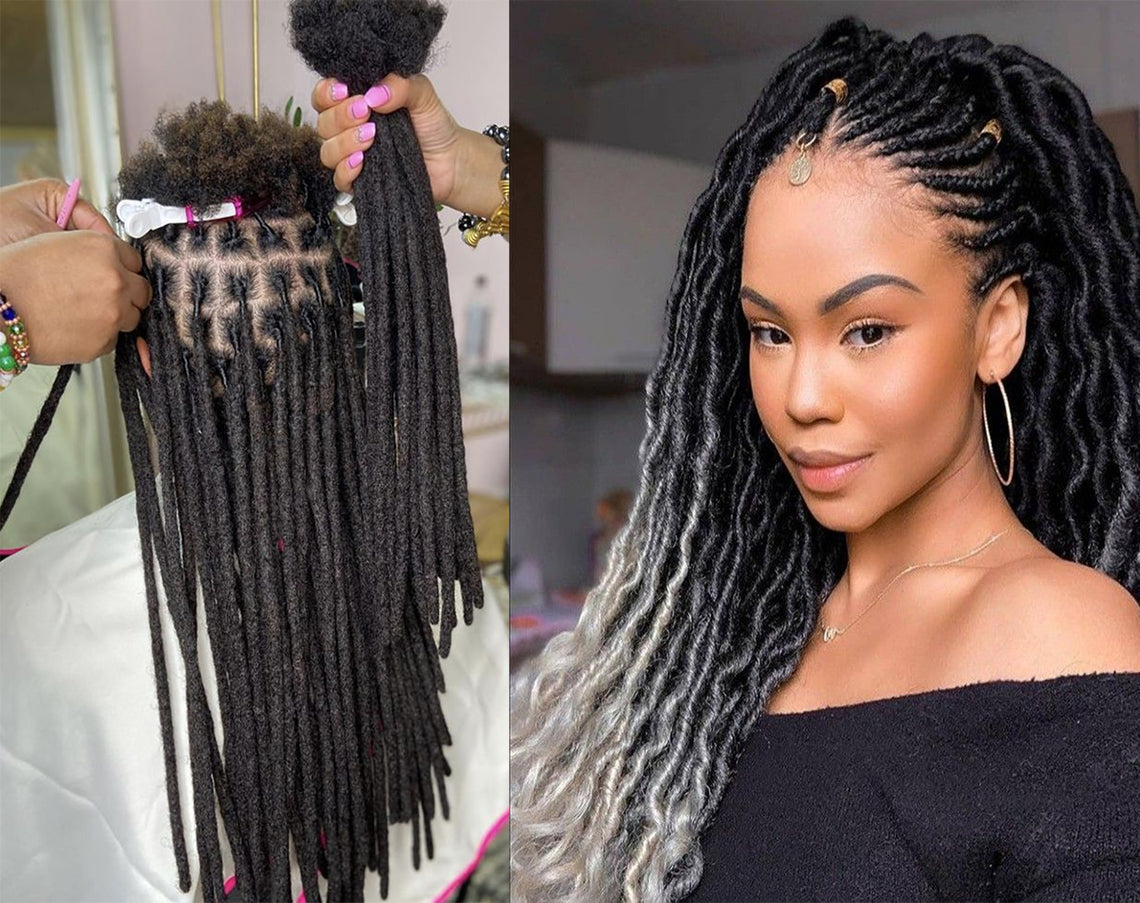How Often Should You Retwist Your Locs?

Now that you've made your locs, you're probably wondering, what next? We can answer that for you. Maintenance!
You need to wash your locs, moisturize, and retwist them periodically to keep them looking as beautiful as they were the day you made them.
In this article, we'll discuss the five loc phases, how often you should retwist your locs, and how you can go longer between retwists.
Let's dive in!

How Often Should You Retwist Your Locs Based on Your Loc Phase
Most locticians and hairstylists believe you should retwist your locs at least once every four to twelve weeks. However, the exact time frame depends on what phase you are in your loc journey. We've listed the loc stages and how often you should retwist during each stage below.
Starter Phase
This is the stage that marks the beginning of your loc journey. This period can go on for three to six months depending on your loc type. Not all loc types go through the starter phase. Instant locs for instance begin at the mature stage.
During this stage, you should retwist your hair every four weeks though the period may be shorter if you have thin hair strands. You should speak to a loctician or hairstylist if you're not sure of your hair type.
To be on the safe side, you can retwist them every two to three weeks in the first one to two months. Be careful though, overtwisting your starter locs can cause thinning and breakage.
Budding Phase
This phase is also called the sprouting stage. It's the second stage of your dreadlock journey and can occur anytime between three to six months after you make your loc for the first time. The exact time they happen can vary because of your hair type, length, texture and thickness.
At this stage, your hair begins to matte together which means you can wash it more without the risk of it unraveling in the shower. Your locs can be in the budding phase for six to twelve months.
The easiest way to know you're in the budding stage is the appearance of new growth. Your locs become unruly and frizzy but don't rush to retwist just yet! Over-manipulating your hair at this point can cause hair damage. The right time to visit the loctician for retwisting at this stage is between every four to six weeks depending on your hair type.
Teen Phase
You get teenage locs between twelve to fifteen months into your loc journey. At this stage, your locs are fuller, longer, thicker and more defined. The teen phase can be unpredictable because your locs can be a bit rebellious. They may start to stick out in every direction, and form bumps. This is why some people call this phase the ugly stage.
Retwisting and palmrolling can help a lot during this stage. You also need constant maintenance because it's the point where you get to visualize what your locs will eventually look like. To keep your hair healthy and growing, you should retwist every four to eight weeks during this stage.
Mature Phase
The mature phase usually comes after fifteen months into your loc journey. During this phase, your locs are longer and more defined. They're also bigger, tighter and uniform.
This is the point where your locs truly become low maintenance because you won't have to visit the loctician as much and you can take care of them at home.
Retwisting during this period should be every eight to twelve weeks to keep your hair looking neat and beautiful.
Rooted Phase
Your locs become rooted between eighteen to twenty four months after your first session. At this stage they reach their full potential and you can enjoy them as much as you want. They also require minimum maintenance.
You should retwist your rooted locs every eight to twelve months or more to prevent them from getting damaged.
It's important to know that how often you really need to retwist depends on your hair texture, maintenance routine, lifestyle and personal preference. Despite what we've mentioned above, if the time frame is not walking for you, we advise that you see a loctician or hairstylist to pick a suitable time frame for your locs.

How Do You Know When to Retwist Your Locs?
You know it's time to retwist your locs when you start seeing a lot of matting, frizzing, and new growth. Ideally, the best time to retwist is right after you wash your hair but if you're going to a stylist or loctician, they'll do that for you.
A rule of thumb is that if you can't see your scalp anymore, your hair is due for relocking. However, if you have freeform locs, that rule doesn't apply because they're thicker, bigger, and not defined at the roots.
What Happens If You Don't Retwist Your Locs?
Depending on your hair texture, style or where you are in your loc phase, you may not need to retwist as often but not retwisting at all is a bad idea.
If you're in the starter phase, not retwisting can make your hair unravel. If you have fine hair, you may get flyaways and your locs may start to lose their thickness as they grow. In some situations, those flyaways may break off.
Other problems you may encounter from not retwisting your hair are as follows:
- Your locs may begin to matt together and look undefined.
- Your locs may break off at the root which may leave gaps in between your hair.
- The locs may start to have holes from joining together in places they shouldn't.
- Thin roots can lead to hair loss if your locs get too heavy for your roots to hold.
- Your locs may break off at the tip.
- Your locs may start to look messy and limp rather than thick and beautiful.
- You can get dandruff, flaking and irritation on your scalp.
What Are the Benefits of Retwisting Your Locs?
Even if you are on semi-freeform or freeform locs, retwisting your hair periodically has a lot of benefits. Some of them are:
- Maintenance: If you want healthy locs, you're going to have to maintain your hair. Retwisting is part of the loc maintaining process and having a routine will help your hair grow long and strong.
- Reduces Breakage: New hair growth at the roots of your loc means it won't be as tight and may begin to tangle or break. Retwisting your locs can prevent this from happening and save you from any future breakage.
- Prevents Unraveling: One of the downsides of not retwisting in the early stages is that your locs may start to unravel especially if you have fine hair. If your locs unravel, you'll have to start your loc journey all over again and that can cost you extra money.
- Locks the Shape In: Retwisting your hair helps you take control of new growth and put them into the shape you want. As your locs grow, it takes the shape that you've been training it into.
- Prevents Hair Thinning: Breakage leads to hair thinning which over time can damage your hair follicles. It can also cause alopecia if the weight of your locs are too much for your scalp.

How Long Does Retwisting Take?
The time it takes you to retwist your locs depends on how skilled the person retwisting is and how many locs you have on your head. If you or the loctician are very skilled and your locs are not that many, it can take between two to five hours to retwist. However, if you have a lot of locs, (like sisterlocks), it can take up to twelve hours even if the loctician is extremely skilled.
Nevertheless, getting a skilled loctician to retwist your locs can save you a lot of time and stress.
How Much Does Retwisting Cost?
How much retwisting costs depends on the following factors:
- The stage you are in your loc journey
- The type of loc you have on your head
- Your location
- Your hair length
- Additional services
Our general estimate is from $50 to $300. Retwists for sisterlocks and microlocs can range from $100 to $300 because you have more hair strands on your head to deal with and they take longer time to retwist. Traditional locs on the other hand can cost between $50 to $100 to retwist.
You can also retwist by yourself at home if you don't have the money to visit a stylist or loctician.

Can You Retwist Your Own Locs?
As we've mentioned before, you can retwist your own locs at home. Retwisting your locs isn't a complicated process as long as you know the steps. It'll also save you some money and help you create an intimate bond with your hair as it grows.
Experts believe that if you're going to DIY your locs, you should do it on wet hair that has recently been washed because it makes it easier to twist.
How Do You Prepare Your Locs for Retwisting?
How you prepare your locs for retwisting depends on whether you're going the DIY route or using a loctician. If you're using a loctician, all you need to do is book an appointment and they'll handle the rest for you.
However, if you're going the DIY route, you should make the following preparations:
- Shampoo Your Locs: Hair that's filled with gunk can be difficult to retwist. That's why you need a shampoo to get rid of the product residue and dirt your locs have accumulated. The rule of thumb is to use a clarifying shampoo twice and moisturizing conditioner right after to reintroduce moisture into your hair. You can also massage your scalp as you use the shampoo to completely remove debris and improve blood flow in your scalp.
- Use a Conditioner: Using a moisture-rich conditioner and leave-in conditioner to seal moisture into your locs during this process will make them appear healthy, and luscious.
- Re-define Your Parts: How you part your hair during the retwisting process depends on what hair style you're going for. To do this, you need your hand, a rat-tail comb and a mirror for precision. If you don't know what parting style will suit your locs, you can always try different parting techniques until you find one you're comfortable with.
- Apply a Twisting Gel or Cream: Using a gel will make it easier for you to retwist your hair. However, it can leave some gunk or residue. To avoid this, you can use a cream and light mist your hair to make twisting faster.
What Tools and Products Do You Need to Retwist Your Hair?

There are some standard tools and products you need to retwist your hair. These standard tools and products are:
- Double prong clips to hold your locs in place while you retwist your hair;
- Extra-large elastic hair bands to separate your hair into sections;
- Clarifying shampoo and hydrating shampoo to wash your hair;
- Conditioner and leave-in conditioner to moisturize your hair;
- Hooded or blow dryer to dry your hair after you retwist it;
- Alcohol-free Twisting Gel or Cream for easy defined twists;
- Silk or satin bonnets to lock in moisture and prevent dryness when you sleep.
How to Start the Retwisting Process
Once you've prepped your locs and gotten the tools, the next step is to start the retwisting process.
- Re-define the parting around your locs with a rat-tail comb until you can see your scalp to make your hair neater.
- Put some gel between your finger and your thumb, place it at the root of your hair and twist away from your face until it can stand by itself.
- Use your clip to secure the retwisted loc at the root to prevent it from unraveling. Then do the same with more locs until you need a new clip.
- Dry your locs with a hooded or hand dryer for thirty to sixty minutes to set the twist. You can also let them dry naturally if you don't have a dryer.
- Remove the clips once the locs are dry. Your locs should look neater and gorgeous.

How Can You Go Longer Between Retwists?
You can go longer between retwists by following the tips below:
- Wear a double-layer shower cap in the bath if you're not shampooing your hair. The extra layer of material on the inside will prevent your hair from steam exposure.
- Wear silk and satin bonnets or scarves at night to prevent your pillow from absorbing the moisture in your hair. Double down with silk or satin pillowcases if you can.
- Don't play or fidget with your locs to prevent it from unraveling.
- Use scalp oil every two to three weeks to add moisture to your roots. Make sure the scalp oil is lightweight and don't apply too much of it.
Retwisting your locs periodically is the secret to healthy and long-lasting locs. However, it doesn't matter whether you DIY your locs or visit a loctician as long as the job gets done and you follow a schedule that suits your hair type and loc stage.








